
 |
|
|
#1 |
|
Home-Wrecker
Join Date: Sep 2008
Location: SE Wisconsin
Posts: 546
Thanks: 3
Thanked 165 Times in 96 Posts
|
I just built a heat exchanger for my DIY solar hot water system.
I am planning on an INSTRUCTABLES on this, but I thought I would tease you all with some photos for now. Basicially, it's a tube inside a tube to that anti-freeze that is heated by a solar panel can heat up otherwise cold water that then goes into an insulated storage tank (an old electric water heater) and then into my standard natural gas water heater. This is sort of a little experiment, and I have never done copper soldering before, so, yes, I already know how sloppy it is! Hot fluid from solar goes in and out the the skinny inner tube, and water to be warmed in the hot water tank thermo-siphons through the thicker outer tube through the T-connections. See all photos at: Solar Heat Exchanger construction - a set on Flickr    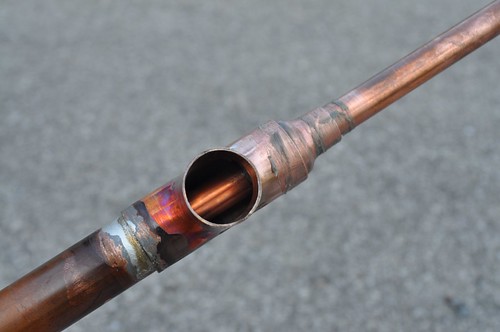 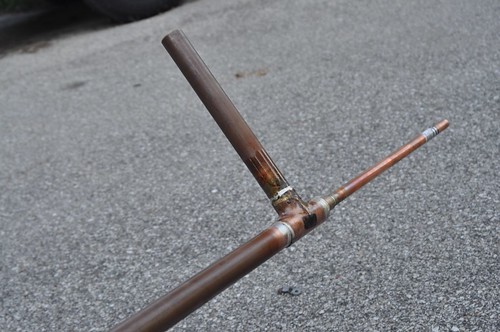   
__________________
To view links or images in signatures your post count must be 0 or greater. You currently have 0 posts. To view links or images in signatures your post count must be 0 or greater. You currently have 0 posts. |
|
|

|
|
|
#2 |
|
Administrator
Join Date: Aug 2008
Location: Germantown, WI
Posts: 5,525
Thanks: 1,162
Thanked 374 Times in 305 Posts
|
Good stuff Ben! Gotta love the tusken raider impression, LOL!
 As I said in my email, I really don't think that is enough surface area. You might need to run several of those lines in parallel. Also, have you pressure tested it yet? I hear thats really the only way to test your soldered joints.
__________________
Current project - To view links or images in signatures your post count must be 0 or greater. You currently have 0 posts. To view links or images in signatures your post count must be 0 or greater. You currently have 0 posts. & To view links or images in signatures your post count must be 0 or greater. You currently have 0 posts. |
|
|

|
|
|
#3 |
|
Apprentice EcoRenovator
Join Date: Dec 2008
Location: mid michigan
Posts: 191
Thanks: 0
Thanked 0 Times in 0 Posts
|
Good job! I was thinking about trying something like that after I saw the "side arm heat exchanger". It seems like a DIY friendly design. What do you figure the materials cost for one like your's? Were any of the fittings odd or hard to find?
Now you could wrap it in insulation to make it more efficient  . . |
|
|

|
|
|
#4 |
|
Home-Wrecker
Join Date: Sep 2008
Location: SE Wisconsin
Posts: 546
Thanks: 3
Thanked 165 Times in 96 Posts
|
I did some more work on the heat exchanger today.
(Yes, I am planning on insulating it...) The next big challenge is to get it to connect to the electric water heater through the heater element ports. Those are straight threads with a gasket. Regular pipe threads will not seal properly into it. At the hardware store, I was able to find a pvc conduit connection that had straight threads and a flat surface where an O-ring could be added. I got a pair of those, along with a chunk of 1" pvc pipe, and two pipe to 1" pipe thread connectors. With all that, I could make a plastic adapter that would go from the water heater to the heat exchanger. However, I still had to solder on the dielectric unions. These allow me to transition from copper to steel pipe, without getting lots of corrosion at the point the two metals meet. A union is also a point where you can unscrew the unit. It would be very difficult to attach to the water tank otherwise! Here is the union soldered in place. Note that it uses a gasket inside against the flat surface. That's similar to how the water heater elements connect to the tank.  Heres the adapter that I made to fit the heat exchanger to the tank.  A #34 O-Ring looked about right for it. 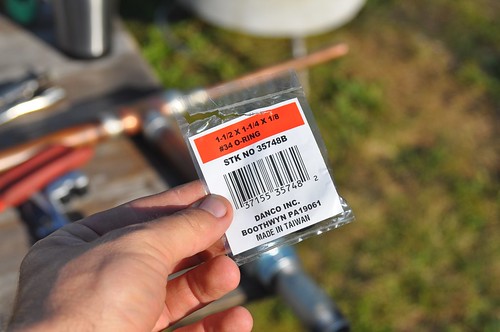 The O-ring slides right on and HOPEFULLY squishes in and seals to the tank. 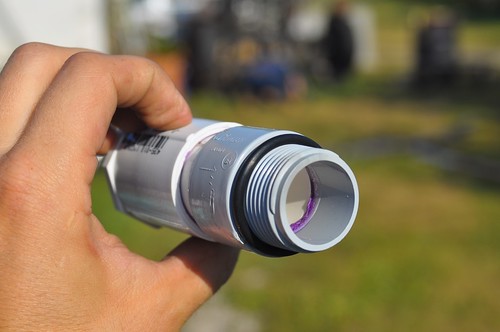 You can see that the arm of the heat exchanger has gotten rather long. Oh well, easier to shorten than lengthen.  Not one but TWO sections of insulation are to go around the heat exchanger. I happened to have a piece to fit the 1" copper tube, and had another chunk that fit the first piece of insulation. I put the one part on, and then the second over the top of it. 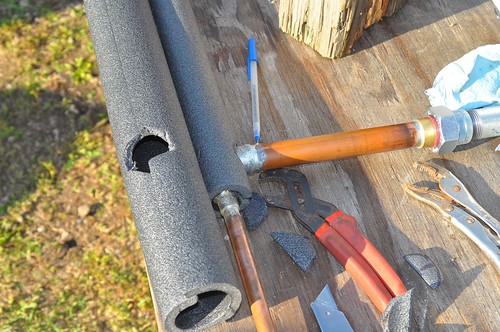 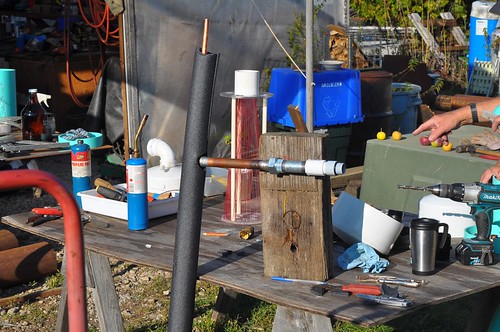 When installed, the entire heat exchanger will be well insulated. I still need to add some fittings to the end of the 1/2" (inside) pipe so that I can connect them to a pump and solar panel. I also need to attach a thermometer to the input of the heat exchanger and inside the hot water tank, so that I can see how much energy is coming from the solar panel, and how much of it actually gets into the tank. So far, none of the parts have been overly expensive to hard to find, although some hardware stores have better selection than others. I stopped at a MegaStore today that carried 2" and 3" diameter copper fittings, but those get expensive real fast! You will also notice that I am not taking photos in my driveway for once! Nope, I traveled over to a friend's farm where they are doing sort of an informal co-op on building wood gasifier technology. The guys there are supportive and have far more soldering experience than I. I also managed to get a free 5 gallon bucket of apples and pears to run through my solar food dryer. 
__________________
To view links or images in signatures your post count must be 0 or greater. You currently have 0 posts. To view links or images in signatures your post count must be 0 or greater. You currently have 0 posts. |
|
|

|
|
|
#5 |
|
Master EcoRenovator
Join Date: Mar 2009
Location: Western Wisconsin.
Posts: 913
Thanks: 127
Thanked 82 Times in 71 Posts
|
Just so you know, I'm pretty sure building code requires any heat exchanger that has antifreeze in it that connects to potable water to have a double wall with the space open to allow drainage should one part of the heat exchanger leak it will not contaminate the potable water... it's screwy.
one way that some heat exchangers are done is the cold water is in your center pipe then some soft copper tubing is wrapped around the outside and soldered on to keep it in place. |
|
|

|
|
|
#6 |
|
Home-Wrecker
Join Date: Sep 2008
Location: SE Wisconsin
Posts: 546
Thanks: 3
Thanked 165 Times in 96 Posts
|
You would ALWAYS want to make sure to use a non-toxic anti-freeze with a single-wall heat exchanger.
I believe that most building codes specifying double-wall go back to when we only had very poisonous anti-freeze. But, building code comment is noted. Right now, this is all just back yard experimenting. The single tube in a tube is pretty easy to build and very efficient. I just test fit the PVC tank adapter into the electric heater element port. It went right in very easily. The O-ring squished right up between the flat lip on the tank and the flat part of the conduit connector. Also, I must have measured close enough, because I was able to connect BOTH ends of the heat exchanger to the tank at the same time. In the back of my mind, there was always a little bit of fear of the exchanger being just enough too long or too short for both ports to line up!
__________________
To view links or images in signatures your post count must be 0 or greater. You currently have 0 posts. To view links or images in signatures your post count must be 0 or greater. You currently have 0 posts. |
|
|

|
|
|
#7 |
|
Lurking Renovator
Join Date: Oct 2009
Location: Just west of Center, WI
Posts: 13
Thanks: 0
Thanked 0 Times in 0 Posts
|
How is this working? I saved my old electric water heater when I put in the new one. I want to make a solar hot water system, but I don't want to freeze it and break something. It's hard enough to get my wife to sign off on something like this.
|
|
|

|
|
|
#8 |
|
Home-Wrecker
Join Date: Sep 2008
Location: SE Wisconsin
Posts: 546
Thanks: 3
Thanked 165 Times in 96 Posts
|
Well, it's not working, because it's not hooked up.
Last week, I took the "Intro To Solar Hot Water" workshop through the Midwest Renewable Energy Association. The instructor told me that external tube-in-a-tube heat exchangers work well in that they are simple and don't clog with sediment the way some other heat exchangers can, but they are pretty in-efficient. Also, after taking the workshop, I don't think I want any plastic involved ANYWHERE in my solar heating system. I used PVC connections to make a coupler to attach the heat exchanger to the hot water tank, but it was only because it was cheap and available. I couldn't find the right brass/bronze parts anywhere. I have just been pretty busy lately, and we have hit our cloudy season about a month early around here. I don't think I will have a "for real" system hooked up until the spring. Until then, I will keep learning all that I can about solar water heating, maybe take another workshop and learn more about solar sighting. In the workshop I took, there was a photo of a tube-in-tube heat exchanger, similar to the one that I made, only it used 2" copper tube on the outside and FOUR 1/2" tubes running through the inside. That makes a heat exchanger with four times the surface area of the one that I built! Building a heat exchanger of that style may be an upcoming project.
__________________
To view links or images in signatures your post count must be 0 or greater. You currently have 0 posts. To view links or images in signatures your post count must be 0 or greater. You currently have 0 posts. |
|
|

|
|
|
#9 |
|
Helper EcoRenovator
Join Date: Feb 2009
Location: Saint Louis, MO
Posts: 59
Thanks: 0
Thanked 0 Times in 0 Posts
|
Could you use Ethyl Alcohol as antifreeze? Not sure what quantity you need, but it'd be fairly non-corrosive and very resistant to freezing. It would be non-toxic (well, depending on your definition - especially bad for a pregnant woman...) and easy to detect by its scent if a leak did occur. I don't drink beer or liquor, but I'll take Ethanol any day over ethylene glycol.
|
|
|

|
|
|
#10 |
|
Home-Wrecker
Join Date: Sep 2008
Location: SE Wisconsin
Posts: 546
Thanks: 3
Thanked 165 Times in 96 Posts
|
I now have metal tank adapters!
I was at the Milwaukee Electric Car Club EV Build Day today. A while back I gave my original electric water heater tank elements to two of the guys to see what they could come up with to re-use the heating elements to make an adapter for standard piping to go into the water heater tank. 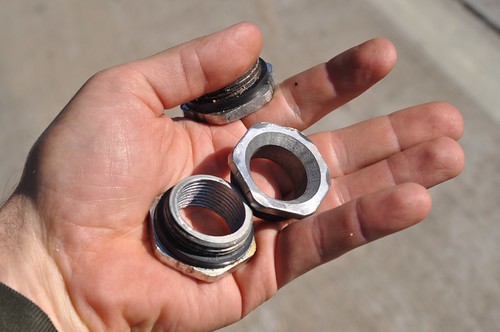 One member took the element, cut it out on the lathe, and tapped out the middle to 3/4ths" female pipe thread. I should be able to screw some standard pipe right into that. The other member modified the element to sort of a scooped-out cone shape. That way we could weld a 1" pipe directly to it to be able to keep the larger diameter pipe, which may still allow for thermosiphoning from the tank, through the heater exchanger and back. I don't know how well this really would work or not, but I do know that bigger pipes are required for it to work. It's pretty interesting how you can give two people the same problem and limitations, and they come up with completely different answers. Either style connector will still use the original flat rubber washer to seal the adapter to the water heater tank, just like the original heater element was.
__________________
To view links or images in signatures your post count must be 0 or greater. You currently have 0 posts. To view links or images in signatures your post count must be 0 or greater. You currently have 0 posts. |
|
|

|
 |
| Tags |
| diy, heat exchanger, solar |
|
|